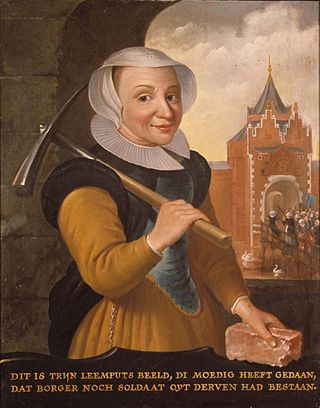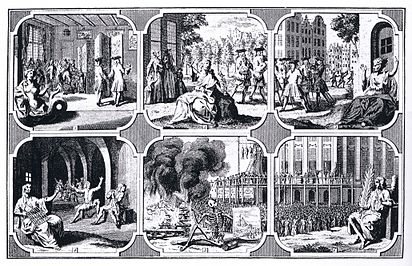
Utrecht is the fourth-largest city of the Netherlands, as well as the capital and the most populous city of the province of Utrecht. The municipality of Utrecht is located in the eastern part of the Randstad conurbation, in the very centre of mainland Netherlands, and includes Haarzuilens, Vleuten en De Meern. It has a population of 361,699 as of December 2021.

The Dom Tower of Utrecht is the tallest church tower in the Netherlands, at 112.32 metres (368,5 feet) in height. It is considered the symbol of Utrecht. The tower was part of St. Martin's Cathedral, also known as the Dom Church, and was built between 1321 and 1382, to a design by John of Hainaut. The cathedral was never fully completed due to lack of money. Since the unfinished nave collapsed in 1674, the Dom tower has been a freestanding tower. The tower stands at the spot where the city of Utrecht originated almost 2,000 years ago.

St. Martin's Cathedral, Utrecht, or Dom Church, is a Gothic church dedicated to Saint Martin of Tours, which was the cathedral of the Diocese of Utrecht during the Middle Ages. It is the country's only pre-Reformation cathedral, but has been a Protestant church since 1580.

The Buggery Act 1533, formally An Acte for the punishment of the vice of Buggerie, was an Act of the Parliament of England that was passed during the reign of Henry VIII.
Margaret Clap, better known as Mother Clap, ran a coffee house from 1724 to 1726 in Field Lane, Holborn, Middlesex, a short distance from the City of London. As well as running a molly house, she was heavily involved in the ensuing legal battles after her premises were raided and shut down. While not much is known about her life, she was an important part of the gay subculture of early 18th-century England. At the time sodomy in England was a crime under the Buggery Act 1533, punishable by a fine, imprisonment, or the death penalty. Despite this, particularly in larger cities, private homosexual activity took place. To service these actions there existed locations where men from all classes could find partners or just socialize, called molly houses, "molly" being slang for a gay man at the time. One of the most famous of these was Clap's molly house.
Molly house or molly-house was a term used in 18th- and 19th-century Britain for a meeting place for homosexual men and gender-nonconforming people. The meeting places were generally taverns, public houses, coffeehouses or even private rooms where men could either socialise or meet possible sexual partners.

The following is the timeline of lesbian, gay, bisexual, and transgender (LGBT) history.

Terms used to describe homosexuality have gone through many changes since the emergence of the first terms in the mid-19th century. In English, some terms in widespread use have been sodomite, Achillean, Sapphic, Uranian, homophile, lesbian, gay, effeminate, queer, homoaffective, and same-gender attracted. Some of these words are specific to women, some to men, and some can be used of either. Gay people may also be identified under the umbrella term LGBT.

Trijn van Leemput was a Dutch heroine of the Eighty Years' War against Spain. According to local legend in Utrecht, she led a large group of women on May 2, 1577, to the castle of Vredenburg and gave the signal to begin demolishing the castle.

COC Nederland, also known as COC Netherlands, is a Dutch LGBTQ+ rights group founded in 1946. COC originally stood for Cultuur en Ontspanningscentrum, which was intended as a "cover" name for its real purpose. It is the oldest existing LGBT organization in the world.

The Society for the Reformation of Manners was founded in the Tower Hamlets area of London in 1691. Its aims were the suppression of profanity, immorality, and other lewd activities in general, and of brothels and prostitution in particular. The society flourished until the 1730s and was briefly revived during 1757.

Sodomy, also called buggery in British English, generally refers to either anal sex between people, or any sexual activity between a human and another animal (bestiality). It may also mean any non-procreative sexual activity. Originally, the term sodomy, which is derived from the story of Sodom and Gomorrah in the Book of Genesis, was commonly restricted to homosexual anal sex. Sodomy laws in many countries criminalized the behavior. In the Western world, many of these laws have been overturned or are routinely not enforced. A person who practices sodomy is sometimes referred to as a sodomite, a pejorative term.
Satan's Harvest Home is a pamphlet published anonymously in 1749 in London, Great Britain. It describes and denounces what it deems the moral laxity and perversion of contemporary society, especially with reference to effeminacy, sodomy, and prostitution. The pamphlet incorporates some older material; this attempts to diagnose the cause of a perceived increase in the prevalence of sodomy among gentlemen. It specifies a continental European origin for both male effeminacy and same-sex relations between females. The pamphlet also features a poem, "Petit Maître", denouncing male habits of feminine dress.

The history of lesbian, gay, bisexual and transgender people in the Netherlands has reflected the shades of tolerance or rigidity which were utilized by the rulers of the country at various periods in its history. Since World War II, the movement for LGBT rights has been galvanized by both events abroad and increasing liberalization domestically.
Joost Schouten was a Dutch East Indies Company figure of considerable repute, in demand as an astute administrator, diplomat, courtier and negotiator for this Dutch colonial and mercantile outpost in the South-East Asian archipelago today known as Indonesia. In July 1644, Schouten was found to have engaged in homosexual sex with numerous men. Convicted of sodomy, a capital offence in the seventeenth-century Netherlands, he was burnt at the stake.
The Christian tradition has generally proscribed any and all noncoital genital activities, whether engaged in by couples or individuals, regardless of whether they were of the same or different sex. The position of the Roman Catholic Church with regards to homosexuality developed from the writings of Paul the Apostle and the teachings of the Church Fathers. These were in stark contrast to contemporary Greek and Roman attitudes towards same-sex relations which were more relaxed.

Gerhardus "Gert" Hekma was a Dutch anthropologist and sociologist, known for his research and publications, and public statements about (homo)sexuality. He taught gay and lesbian studies at the Faculty of Social and Behavioral Sciences of the University of Amsterdam from 1984 to 2017.

Guido Guerra V (1220-1272) was a politician from Florence, Italy. Aligned with the Guelph faction, Guerra had a prominent role in the political conflicts of mid-thirteenth century Tuscany. He was admired by Dante Alighieri, who granted him honor in the Divine Comedy, even though he placed Guerra in Hell among sinners of sodomy.
Female sodomy is a general category of sexual or erotic activities enacted between women. It was codified as a legal category in medieval and early modern Europe, although it differed greatly between regions. Female sodomy is distinct from the social and legal category of (male) sodomy due to the significant differences in the way women accused of sodomy were seen in society and treated within the court system. A person who commits sodomy is sometimes referred to as a sodomite. Notable historical female sodomites include Katherina Hetzeldorfer and Benedetta Carlini.
















